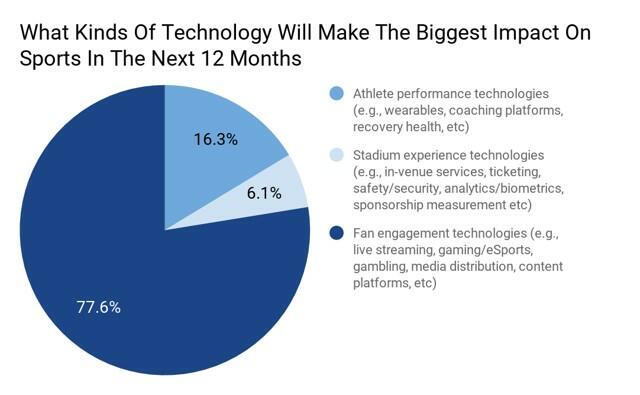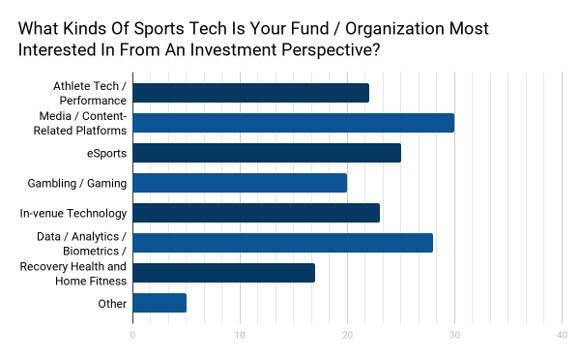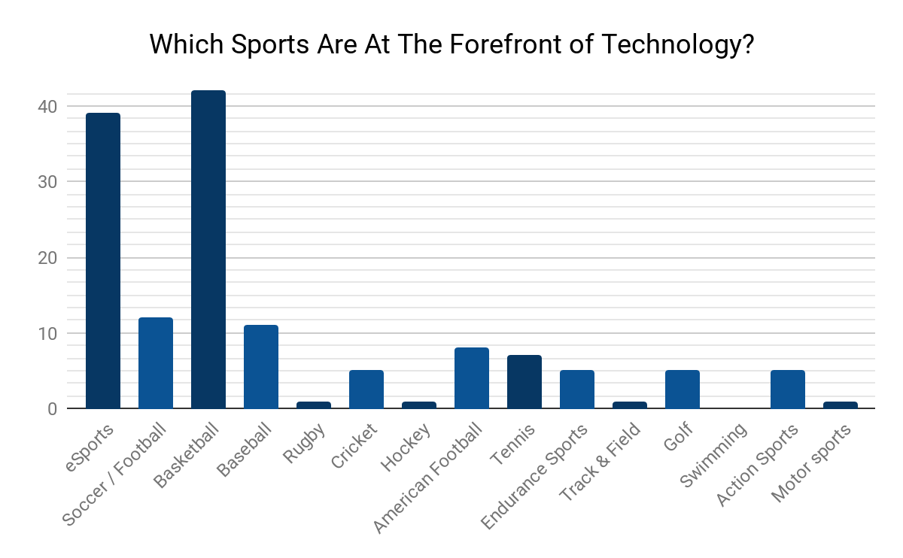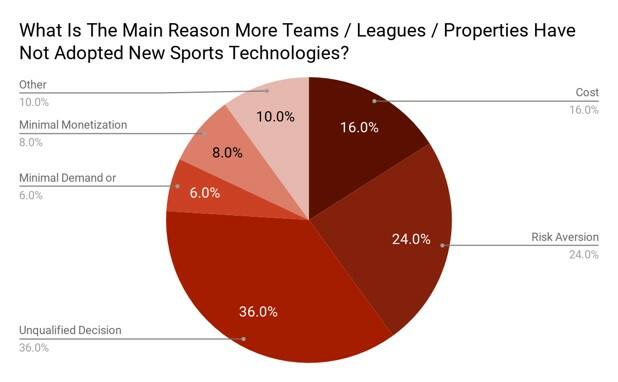Pyr Marcondes
1 de março de 2020 - 7h49
O mundo do Sports Tech está em franca ascenção global e, incrivelmente, justo no País do futebol e de tantos outros esportes olímpicos em que o Brasil manda bem, esse setor, em que a tecnologia anaboliza e otimiza o esporte em “n” áreas e de “n” formas, não se fala devidamente do tema.
A associação Brazil Sports Tech (com “z” mesmo, porque esse game é global) saiu na frente e congrega algumas das mais importantes startups e iniciativas dessa nova visão do esporte por aqui.
Recentemente, publiquei estudo inédito da NovoEsporte listando 100 startups e iniciativas brasileiras da área.
E ainda outro sobre como a FPF entrou nesse jogo com Inteligência Artificial.
Abaixo, reproduzo artigo publicado originalmente na Forbes, sobre os 5 aspectos que serão mais imapctados na indústria do esporte pela presença da trecnolgia.
Mais abaixo ainda, reproduzo outro artigo, esse publicado originalmente no TechCrunch, que detalha onde e como os investidores estão olhando esse business.
Para marcas e todo o mercado do marketing e da comunicação, esse é um campo de grama bem verdinha para jogar. E fazer gol.
Five Aspects Of The Sports Industry Most Impacted By The Proliferation Of Sports Tech
Patrick Rishe
Earlier this week, I had the pleasure to moderate a panel discussion at the 2020 Stanford Sports Innovation Conference. The panel’s focus was on the proliferation of sports technology, exploring the various areas of the sports industry most impacted by advances in technology.
The five areas of the sports industry where advancements in technology have had the greatest impact are:
1) Media and Content
2) Fan Engagement
3) Athlete Performance
4) Venue Design
5) Various Aspects of Business Operations
Let’s discuss each of these in more depth:
1) Media and Content
With advancements in technology, every person with a smart device becomes their own media content creator and distributor. And their ability to distribute has become enhanced with the greater speed of WiFi connectivity and the expansion of various social media channels.
Additionally, advancements in sports tech impact how leagues are able to present their sport to fans. This example featuring the partnership between Second Spectrum and the Los Angeles Clippers is but one example of enhancing the viewing experience using augmented reality.
The explosion of sports streaming services is a reaction to how millennials and GenZ fans increasingly consume content in a mobile fashion.
While the expansion of digital media has had an influence on personalized marketing and the gamification of sports.
And though it is far too early to gauge the long-term viability of the XFL, they have introduced audio innovations which are made possible through technology.
2) Fan Engagement
Better technology enables better data capture of customers through mobile ticketing, which allows teams/leagues to know more about their customers…and quickly. This allows teams/leagues a variety of ways to enhance their ability to connect with fans…which ultimately should boost fan engagement.
This includes more personalized targeted marketing to better cater to a fan’s revealed preferences (e.g. for certain opponents, certain merchandise, certain seating locations within the facility, etc…). Or providing better in-game entertainment by knowing, for example, which type of music goes over well with the audience, or what type of corporate activations in the concourse resonate more strongly with patrons.
Fantasy sports have had a major impact on fan engagement. And now that gambling is slowly becoming legalized across more states, and with in-game betting becoming a larger share of the overall “betting action”, technology plays a critical role in fans being able to access sports data, betting information, and place bets quickly.
3) Athlete Performance
With the margins between success and failure seemingly narrower than ever before, athletes are looking for every feasible edge they can find, as are the trainers and performance staffs tasked to maximize the productivity of their athletes.
To that end, wearable devices have certainly disrupted the industry. For example, Zephyr produces a compression shirt (or a sports bra) that can directly measure key inputs (e.g. heart rate, breathing rate, heart rate variability, posture and impact), which is then used to deduce more than 20 secondary parameters such as jump height and flight time, explosiveness, peak force, heart rate confidence, estimated core body temperature, percent of heart rate at anaerobic threshold, heart rate recovery, physiological load, physiological intensity, etc.
Additionally, supplemental tools which track the objects used by athletes help lend technical insights which the athletes and their coaches can use to boost performance. For example, Rapsodo produces a pitching device which tracks pitch velocity, spin rate, true spin rate, spin axis, and spin efficiency as well as strike zone analysis, horizontal and vertical break, and 3D trajectory. They also measure the impact of spin on every ball and the actual flight of a pitched baseball, calculating the corresponding trajectory of the same pitch without spin.
Another supplemental tech device produced to enhance performance comes from Halo Neuroscience. As detailed in this story featuring its use by the San Francisco Giants, their Halo Sport product helps athletes retain muscle memory faster by stimulating neurons during training, causing a process of hyperplasticity which induces hyper muscle learning.
4) Venue Design and Logistics
The speed and quality of WiFi connectivity within the venue drives numerous aspects of the fan’s game-day experience. Whether entering the building with mobile ticketing, watching replays, visiting an online merch store, posting on social media, or placing a bet, all of these potential aspects of the fan’s experience rely heavily on ensuring the facility has the highest quality of WiFi.
Teams increasingly either build their own apps or outsource with companies like VenueNext to provide a one-stop-shop on game-day to maximize the fan’s experience at the venue. For example, the VenueNext app enables an assortment of services such as mobile entry, wayfinding within the venue, best ingress and egress outside the venue, concessions deliver to your seats, merchandise purchases, consumption of replays, and more.
5) Various Aspects of Business Operations
For the teams with the most advanced business intelligence departments, these departments work laterally with all other divisions within business operations, including:
- Ticketing (including ticket pricing, customer prospecting, ticket renewals)
- Corporate Partnerships (including prospecting and renewals)
- Marketing (more knowledge about fans allow more personalized targeted messaging)
- Retail (can track supply and demand in real-time, allowing for better inventory management)
- Food and Beverage (can track real-time tastes/preferences, providing better customer service while making the supply-chain more efficient)
- Public Relations and Community Relations.
Of course, coordinating all these different data sources requires a strong data warehouse…which itself is not possible without quality tech. Data warehousing services offered by KORE, Amazon Redshift, and others can be the real off-field stars of the sports business industry because their effective assimilation of big data helps teams become more operationally efficient in maximizing revenues and curtailing costs.
————————————————————————————————————–
The Future of Sports Tech: Here´s Where investors are placing their bets.
By Michael Proman (*)
Image Credits: Catherine Lane / Getty Images under a license.
Sports have always been the ultimate unifier — transcending geographic borders, rising above partisan politics and enabling multiple audiences (and generations) to find alignment — the little-known secret behind this global unifier? Technology.
Technology influences how athletes train and compete, how fans engage and consume content and how world-class venues are constructed. Technology has been quietly transforming the world of sports for years, with investment in areas like esports continuing to rise, surpassing a total of $2.5 billion in VC funding in 2018 — and some estimates predicting the sports tech sector will reach $30 billion by 2024.
With the 2020 Tokyo Olympics less than a year away, a massive amount of investment and innovation are pouring into the sports technology industry ahead of this globally unifying event. But which technologies are making the biggest impact? Where are investors placing their bets? Which sports are at the forefront of the technology revolution and which factors are holding the industry back?
In an attempt to pull the curtain back on the sports tech industry, we conducted a survey, The Current State of Sports Technology, of industry experts, including investors, founders and professionals from teams, leagues and media properties, to answer these very questions. Below you’ll find some key takeaways from our findings, pointing to the areas we believe the industry is headed in the year to come.
Fan engagement technologies, including live streaming and esports, are set to make the largest impact on sports in the next 12 months
When asked about which technologies would make the biggest impact on the sports industry in the next 12 months, an overwhelming 78% selected fan engagement technologies, such as live streaming, esports and content platforms, compared to technologies related to athlete performance (16%) and stadium experience (6%). Respondents also believe that this will hold true for the upcoming 2020 Olympic Games in Tokyo.

“Anticipating the next fan engagement trend is critical, whether you’re a team, brand or media company,” says Tom Masterman, global head of Publisher Sales at Genius Sports Media, a leading provider of sports data and technology solutions. “Tokyo 2020 will be a make-or-break event for startups as well as incumbent technologies.”
Having worked on two Olympics at previous digital media companies, Masterman is aware of how quickly the Games come and go. “Among the questions that will keep many of us up at night include, ‘Will fans adopt my tech? Is my sponsorship integration a good experience? Did I choose the right channel partners?’ ”
Top three technologies for investment: Media and content-related platforms; measurement platforms for data, analytics and biometrics; and esports

From an investment perspective, media and content-related platforms, esports and measurement platforms for data, analytics and biometrics were among the top three areas of interest. Other notable areas include athlete tech and performance optimization, in-venue technology, gambling and gaming and recovery health and home fitness. This is a powerful indication of where venture capital funding focus is trending, given that more than 50% of respondents, coming from a wide array of areas in the industry, identified themselves as investors.
“As investors, we see cyclicality in every industry except sports, which has the biggest consumer ecosystem. Sports had been a very traditional industry powered by legacy tech, but now with the advent of streaming, sports content media distribution is decentralized via social media platforms,” says Gayatri Sarkar, managing partner at Hype Capital, who offered her take on this investment trend. “The sports market has the opportunity to be a multitrillion-dollar ecosystem with technological advances such as 5G, digital collectible trading and the rise of esports, which will fuel new market and social behavior. As the infusion of deep tech continues in smart venue, gambling, performance biometrics and many more sub verticals where data is the engine, we’ll naturally see more and more deep tech investors entering the sports investment landscape.”
Basketball and esports are at the forefront of technology
While esports is a likely leader in the use of technology, with 79% of respondents placing it in the top three category, basketball remains the top pick, with 87% placing the traditional sport at the forefront of innovation.

As a former NBA-er*, this comes as no big surprise. The league has always been known as a thought-leader in technology and innovation, and their dominance is what is driving the sport’s tech-savvy DNA on a global level.
When talking to Tom Hunt, EVP, Business Operations at the Sacramento Kings about his take on innovation in the NBA, he placed technology as a top priority. “Golden 1 Center is one of the most technologically advanced and connected indoor arenas in the world, and serves as our 21st Century communal fireplace,” said Hunt. “We’ve been at the forefront of leveraging technologies such as AI, AR, blockchain and esports (Kings Guard Gaming/NBA 2K) to deepen connections to our brands while customizing and personalizing frictionless fan experiences remains core to our mission.”
That being said, I’d make a bet that baseball-related technology will catch up very quickly. We’ve seen several startups currently working with baseball clubs — enhancing everything from a player’s cognitive reactions to the ways in which your food is delivered to you at ballparks.
What’s holding back sports tech adoption?

Respondents cited several factors holding back sports technology adoption, with the top three reasons, similar to many non-traditional technology sectors, being unqualified decision makers, risk aversion and cost.
While there’s plenty of blame to go around (and everyone can assume a degree of responsibility), startups in the space need to validate their business model outside of a core sports stakeholder. They need to realize revenue from more than just sports teams, leagues and properties — organizations that have historically reinforced the leading responses to this question. More importantly, relationships with these audiences require long sales cycles and traditionally represent “cents on the dollar” in comparison to partnerships with other industry (e.g. brands) and non-industry (e.g. military, retail, airline, etc.) opportunities.
Parting thoughts
The sports tech industry has and continues to suffer from massive amounts of fragmentation. Whether it be by geography, industry area of focus or funding stage, sports tech startups are missing the community that it has enabled others to realize.
There is a historic opportunity to bring this community together, and when we do, the legacy that we create will be one of continued growth and opportunity — perpetuating the current influx of capital into the space and reinforcing the notion that sports are truly the ultimate unifier.
*I worked for the NBA for more than four years in Global Business Development.
(*) Michael Proman is managing director at Scrum Ventures .






